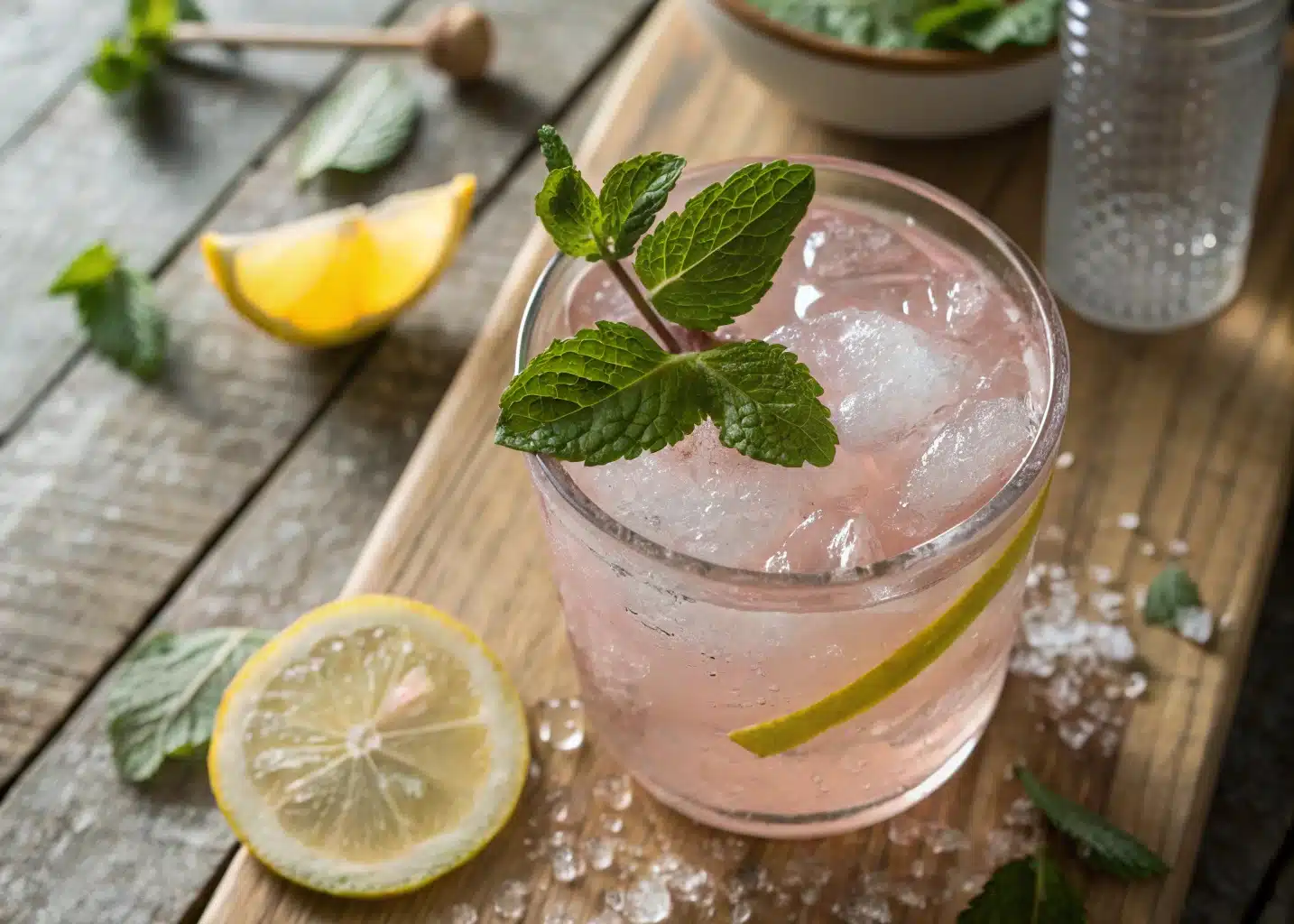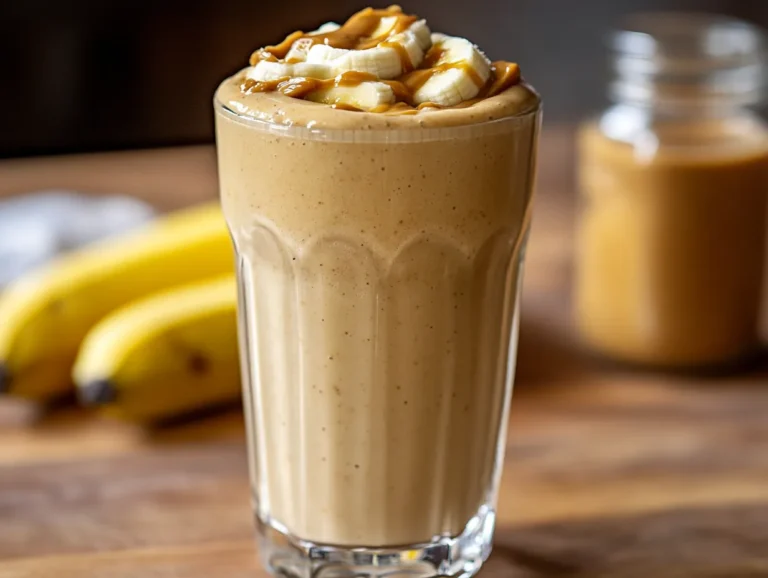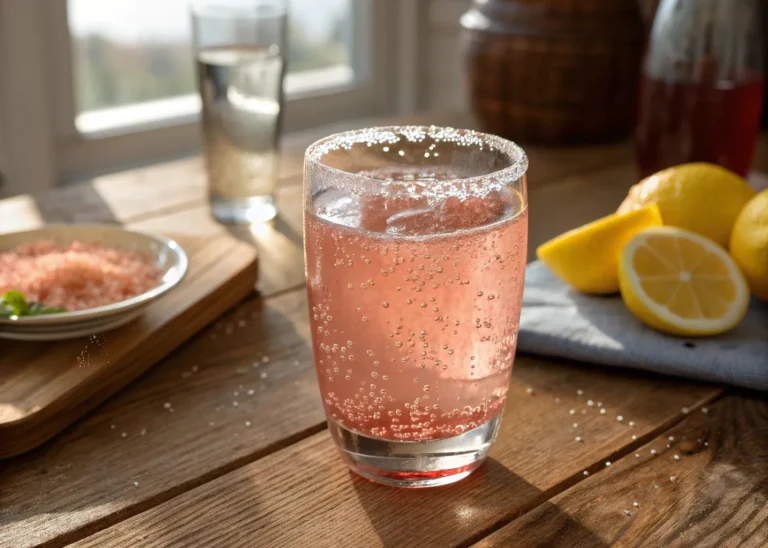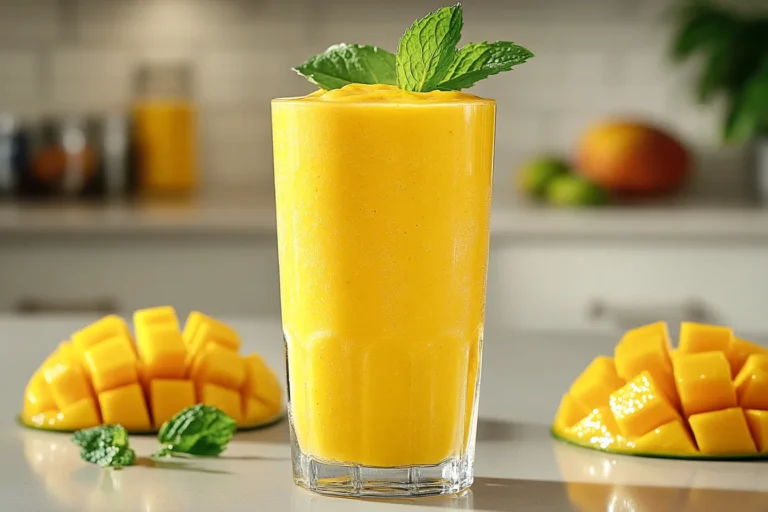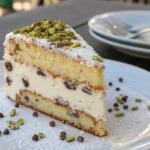When your body’s running low on energy, hydration is everything—and not all water is created equal. That’s where the Japanese pink salt recipe comes in. This mineral-rich, all-natural electrolyte drink is gaining attention for good reason. It’s simple, clean, and incredibly effective. Made with nothing more than warm water, pink salt, lemon, and honey, it’s a wellness powerhouse you can mix up in minutes.
It’s not just about quenching your thirst—it’s about replenishing what your body actually needs. This isn’t just a hydration trend. It’s a daily ritual for many who want natural energy, better digestion, and balance from the inside out.
Looking for inspiration? Try this refreshing Matcha Lemonade recipe for another smart, sippable wellness drink.
Let’s kick things off by diving into what makes this ancient ingredient so different—and why it’s finally getting the attention it deserves.
Table of Contents
Discovering Japanese Pink Salt
What Is Japanese Pink Salt and Why It’s Special
Japanese pink salt is not your average table salt. Unlike the ultra-refined kind most of us are used to, this salt is hand-harvested from traditional Japanese salt flats and coastal seawater, then sun-dried to preserve its natural mineral content. Its pale rose hue comes from the trace minerals still intact—like magnesium, potassium, and calcium.
In terms of taste, Japanese pink salt is softer and subtler than many other gourmet salts. It dissolves quickly in water and doesn’t overpower the other flavors in your drink, which makes it ideal for recipes like this one. Plus, it’s incredibly clean, both in production and impact—no additives, no bleaching, no anti-caking agents.
It’s also been used in Japanese cooking for centuries—not just for flavor, but for its believed ability to help restore balance, regulate hydration, and gently support digestion. Today, it’s often used in clean beauty routines, hydration hacks, and gut health tonics.
If you’re tired of sugary sports drinks and overpriced “health” beverages, Japanese pink salt might be your new wellness staple.
Japanese vs Himalayan Salt: A Quick Comparison
These two salts are often confused, but they’re not created equal. Here’s how they stack up:
| Feature | Japanese Pink Salt | Himalayan Pink Salt |
|---|---|---|
| Source | Seawater (Japan) | Rock mines (Himalayan region, Pakistan) |
| Color | Pale pink to soft rose | Deep pink to orange |
| Texture | Fine, moist, dissolves quickly | Coarse, dry, needs grinding or extra time to mix |
| Taste | Mild, mineral-balanced, low bitterness | Stronger, earthy, slightly metallic |
| Primary Minerals | Magnesium, calcium, potassium | Iron, calcium, magnesium |
| Best For | Beverages, detox drinks, subtle seasoning | Grilling, meats, coarse applications |
What sets Japanese pink salt apart for hydration? Solubility and flavor. Its fine texture melts into water almost instantly, without any gritty residue or lingering saltiness. You get all the electrolyte benefits, without that strong mineral aftertaste.
Health Benefits of Japanese Pink Salt Recipe
Natural Electrolytes and Detox Support
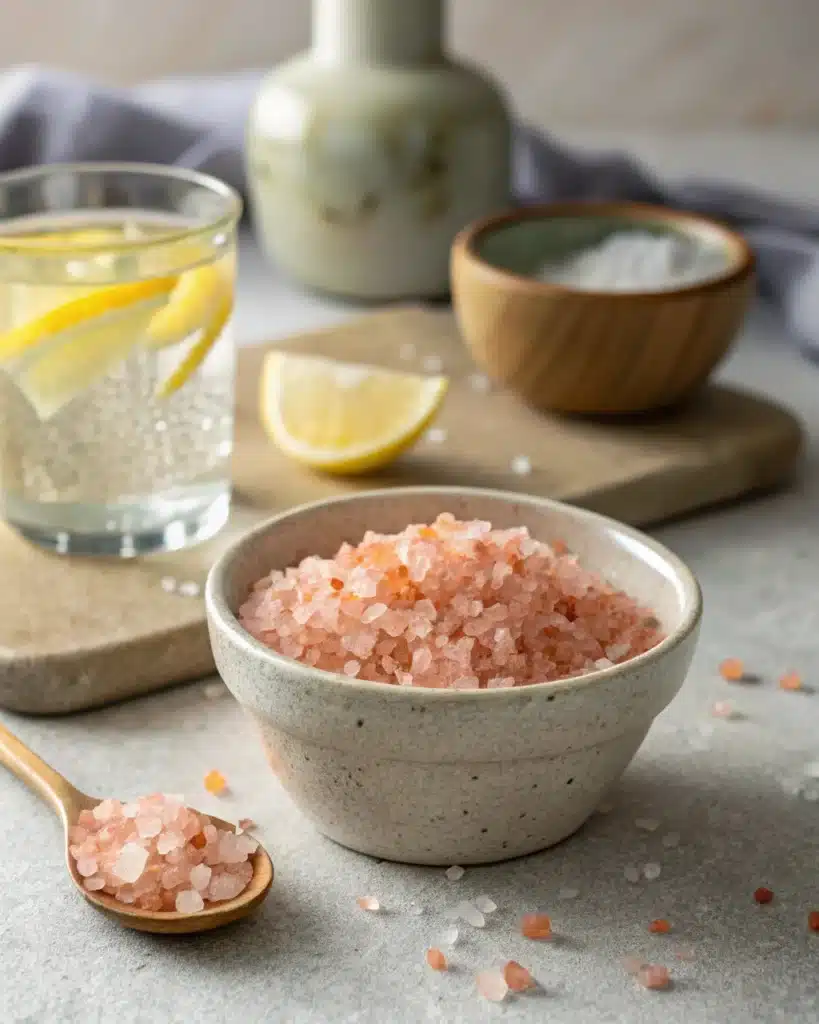
When your body sweats, it loses more than just water—it loses minerals called electrolytes. These are essential for everything from muscle function to nerve signals and hydration balance. That’s where this Japanese pink salt recipe comes in.
The salt itself contains sodium, magnesium, potassium, and calcium—the same minerals your body loses through sweat, stress, and heat. When added to water and paired with fresh lemon juice and a touch of honey, this drink becomes a natural electrolyte solution without synthetic ingredients or sugar overload.
Here’s how each key mineral plays a role:
| Mineral | Function in Body |
|---|---|
| Sodium | Balances fluids, supports nerve/muscle function |
| Potassium | Regulates heartbeat, supports hydration |
| Magnesium | Calms nerves, supports muscles and sleep |
| Calcium | Aids in nerve signals, muscle movement |
Unlike commercial sports drinks, which often rely on processed sugar and artificial color, this pink salt tonic gives your body what it actually needs—without anything it doesn’t.
This recipe is especially useful for:
- Post-workout recovery
- Sauna or hot yoga sessions
- Low-carb or keto diets
- Morning dehydration
- Replenishing after a long flight
How It Helps With Hydration, Energy & Digestion
This isn’t just about replacing electrolytes. It’s about functional wellness.
Hydration: Pink salt enhances your body’s ability to absorb and retain water, which means you stay hydrated longer. When combined with lemon and warm water, it also helps activate your digestive system first thing in the morning—often referred to as an “internal cleanse.”
Energy: Many people report a noticeable boost in energy after drinking this tonic. Why? The minerals help stabilize blood sugar and balance pH levels, while lemon provides a small dose of vitamin C. Raw honey adds a natural glucose boost for sustainable energy without a crash.
Digestion: The acidity of lemon plus the mineral complexity of salt supports the production of stomach acid and bile—both essential for breaking down food. Many traditional Japanese and Ayurvedic approaches recommend salt water in the morning to kick-start metabolism and improve nutrient absorption throughout the day.
Pro tip: Sip slowly on an empty stomach first thing in the morning for the best results. Then wait 15–20 minutes before eating breakfast.
Ingredients for the Best Japanese Pink Salt Recipe
Core Ingredients Explained (Salt, Lemon, Honey, Water)
At its heart, the Japanese pink salt recipe is simplicity at its best—four clean ingredients with real benefits, all working together to hydrate, restore, and energize. Here’s a closer look at each one and why quality matters.
1. Japanese Pink Salt
The star of the show. Look for fine-grain pink salt sourced from Japan—not to be confused with Himalayan salt. It should be unrefined, sun-dried, and free from additives. The mineral balance is what gives this salt its hydrating superpower. Just one teaspoon contains enough electrolytes to support your body’s natural fluid retention and cell function.
2. Filtered or Spring Water
Start with clean, pure water. Tap water often contains chlorine or other minerals that can interfere with the flavor or benefits of this drink. Filtered or spring water ensures clarity and taste—especially if you’re sipping it warm in the morning.
3. Lemon Juice
Lemon isn’t just for flavor — it’s a natural detoxifier, rich in vitamin C, antioxidants, and digestive enzymes. According to the Cleveland Clinic, lemon water may support hydration, stimulate digestion, and promote fullness as part of a balanced daily routine.
4. Raw Honey
Used in moderation, honey balances the acidity of lemon and the salinity of the salt. It also provides natural glucose, which helps fuel your brain and body without causing a blood sugar spike. Look for raw, unfiltered honey to retain its enzymes and antibacterial properties.
Ingredient Substitutions & Vegan-Friendly Tweaks
Every body is different. Here’s how you can adapt the recipe without compromising its core benefits:
| Ingredient | Substitution | Why It Works |
|---|---|---|
| Honey | Maple syrup or agave nectar (vegan) | Still adds natural sugar + antioxidants |
| Lemon juice | Fresh lime juice | Tangier profile, same vitamin C benefits |
| Japanese salt | High-quality sea salt (if unavailable) | Choose fine, unrefined, mineral-rich sea salt |
| Warm water | Iced water (summer option) | Hydrating alternative for warm weather sipping |
You can even experiment by infusing the water with cucumber slices, mint, or ginger to level up the flavor—and the benefits.
Check out our Brazilian Mounjaro recipe for another light and rejuvenating drink you can pair with your wellness routine.
Step-by-Step – How to Make the Japanese Pink Salt Recipe
Simple 5-Minute Recipe Guide
This Japanese pink salt recipe is as easy as it is effective. No complicated tools, no fancy ingredients. Just a simple process you can do every morning—or whenever your body needs a clean hydration reset.
Here’s how to make the perfect glass:
✅ Ingredients:
- 1 teaspoon Japanese pink salt
- 2 cups filtered or spring water
- 1 tablespoon fresh lemon juice
- 1 teaspoon raw honey (optional, adjust to taste)
- Ice cubes (optional)
✅ Instructions:
- Boil your water.
Heat 2 cups of filtered water until it reaches a rolling boil. If you prefer an iced version, simply warm just enough water to dissolve the salt, then chill the rest. - Cool slightly.
Remove from heat and let the water sit for 1 minute. Adding salt to overly hot water can reduce its mineral content and alter the taste. - Add the pink salt.
Gently stir in 1 teaspoon of Japanese pink salt until it completely dissolves—this step is where the magic happens, so take your time to get it right. - Add lemon and honey.
Mix in the fresh lemon juice and raw honey. Stir until completely blended. - Serve and sip.
Pour into your favorite glass and sip warm—or chill it over ice for a cool, refreshing version.
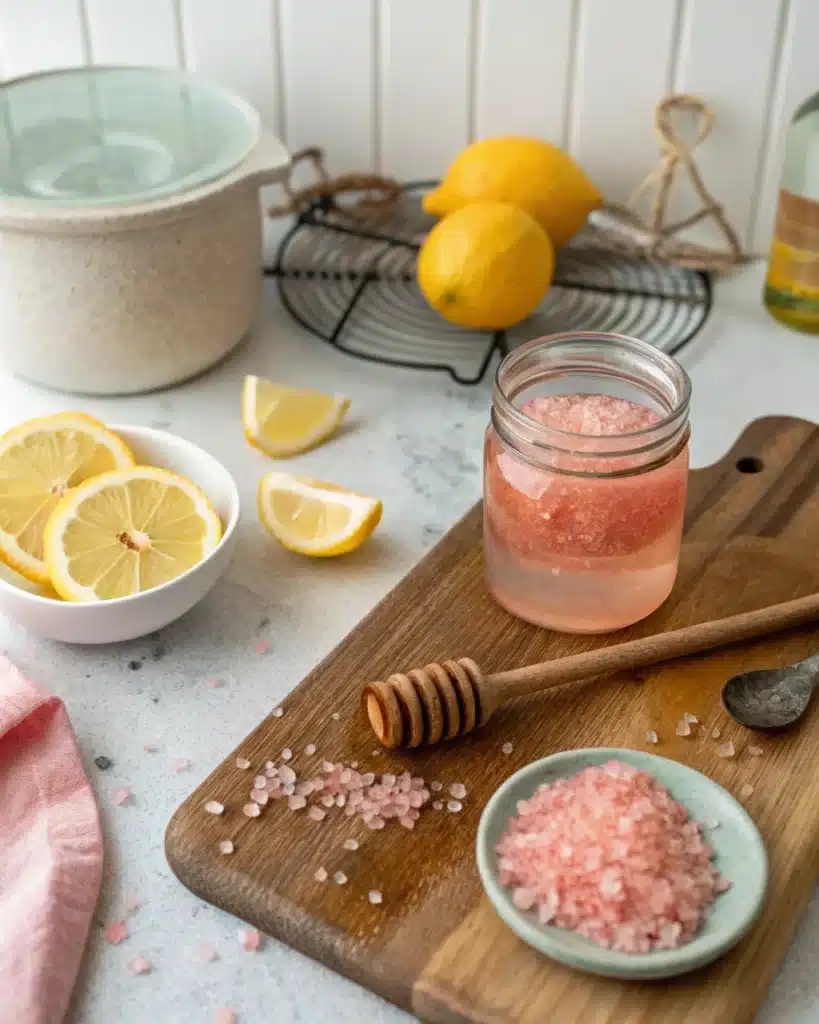
Pro tip: Always stir well before serving if the drink has been sitting. You want every mineral-rich sip to be consistent.
Best Practices for Flavor and Texture
Want to elevate your drink? Use these quick tips to avoid common mistakes and get the most out of each ingredient.
- Don’t use tap water if it tastes strongly of chlorine or minerals—it competes with the salt’s delicate flavor.
- Taste before adding more honey. Start with a teaspoon and build gradually. This is meant to taste balanced, not sweet.
- Add a lemon slice as a garnish—it’s more than decoration; it brings a pop of brightness and a burst of citrus in every sip.
- Avoid metal containers. Salt and lemon are both reactive—use glass or BPA-free bottles for storage.
Here’s a quick visual breakdown:
| Step | Tip |
|---|---|
| Boil water | Don’t overboil; overcooking affects minerals |
| Add salt | Stir slowly and fully dissolve |
| Mix-ins | Add lemon and honey only after cooling a bit |
| Serve | Warm or iced, but always stirred |
When & How to Drink Japanese Pink Salt Water
Ideal Timing for Wellness (Morning, Post-Workout, Travel)
When it comes to reaping the full benefits of the Japanese pink salt recipe, timing matters. This isn’t just something you sip randomly throughout the day—there are optimal moments where your body is primed to absorb minerals and hydration more efficiently.
Here’s when to drink it:
🌅 First Thing in the Morning (Fasted State)
This is the most popular and effective time. After a night of rest, your body is slightly dehydrated and low on electrolytes. Drinking this warm, mineral-rich water upon waking helps:
- Activate digestion
- Support liver detox
- Gently stimulate metabolism
- Rehydrate cells quickly
Just drink it on an empty stomach, wait 15–30 minutes, then enjoy breakfast. It’s the perfect morning ritual.
🏋️ Post-Workout Recovery
After sweating, your body loses sodium, potassium, and water—especially during intense workouts, sauna, or hot yoga. This pink salt drink works like a clean electrolyte formula, restoring hydration without synthetic ingredients.
Drink within 30 minutes after exercise for the best results.
✈️ During or After Travel
Long flights, road trips, or even air-conditioned environments can dehydrate you fast. The lemon in this recipe also helps support your immune system while traveling. Pack a dry mix (salt + lemon powder) and mix with bottled water on-the-go.
☀️ Hot Weather or Heat Exhaustion
Feeling wiped out in summer? Instead of sugary sodas or sports drinks, sip this over ice. The minerals help balance sodium levels, prevent headaches, and reduce fatigue from heat stress.
Who Should Avoid or Limit It (Medical Notes)
While this drink is safe for most people, it’s always smart to be aware of your body’s needs. Here’s who might want to consult with a healthcare provider before making it a daily habit:
- People with kidney disease – Excess sodium can add strain
- Those on a sodium-restricted diet – This recipe is salt-forward by design
- Individuals with hypertension – Always check with your doctor first
- Children under 5 – Not recommended unless diluted and approved
Also, listen to your body. If you feel bloated or thirsty after drinking it, reduce the salt amount or frequency.
Looking for a sweet and cooling balance to your hydration routine?
Check out this Blackberry Sage Lemonade Refresher for a complementary wellness sip packed with herbs and antioxidants.
Variations to Keep It Fresh
Add-Ins Like Mint, Ginger, Cucumber, or Chia
Sticking to a wellness habit is easier when it doesn’t feel repetitive. The good news? You can mix up your Japanese pink salt recipe without losing its benefits. These variations add flavor, boost function, and keep things seasonal.
Here are some creative and beneficial twists:

1. Fresh Mint Leaves
A handful of crushed mint adds a spa-like freshness and mild cooling sensation. It’s ideal for summer sipping, especially when served over ice.
Bonus: Mint supports digestion and soothes the stomach.
2. Ginger Slices
Adding 2–3 thin slices of raw ginger while the water is still warm turns this into a powerful anti-inflammatory tonic. Ginger adds warmth, helps with nausea, and stimulates circulation.
3. Cucumber Rounds
Drop in a few thin cucumber slices for a subtle, refreshing hydration boost. Cucumber is water-rich and cooling—great for after workouts or hot weather days.
4. Chia Seeds
Add 1 teaspoon of chia seeds and let them soak for 10–15 minutes. They swell up and turn the drink into a hydration gel, perfect for longer periods of energy release or digestion support.
5. Citrus Twist
Swap out lemon with lime or even orange for a different flavor profile. Each brings its own antioxidant and vitamin C benefits.
| Variation | Flavor Profile | Added Benefit |
|---|---|---|
| Mint | Cool, herbal | Digestive support |
| Ginger | Spicy, earthy | Anti-inflammatory, warming |
| Cucumber | Light, crisp | Cooling, hydrating |
| Chia Seeds | Mild, textured | Fiber, sustained hydration |
| Lime or Orange | Tangy, citrusy | Antioxidant, flavor variety |
You can also combine two or three at once. Try mint + lime + cucumber for a true spa blend.
Seasonal Twists: Warm vs Iced Versions
Your body craves different things depending on the time of year. Adjusting your pink salt drink by temperature can help you stay aligned with your environment and energy needs.
❄️ In Winter:
Serve it warm, with ginger and lemon. It becomes a comforting, gently detoxifying morning tonic.
☀️ In Summer:
Pour it over ice, add cucumber and mint. It’s instantly cooling, hydrating, and perfect for sunny days or post-beach recovery.
Warm version = circulation + digestion
Iced version = hydration + heat relief
What Science Says – Nutrition + Mineral Breakdown
Sodium, Potassium, Magnesium: Why They Matter
Your body thrives on balance—especially when it comes to hydration. That balance hinges on electrolytes: electrically charged minerals that regulate fluid levels, pH, muscle function, and nerve signals. The Japanese pink salt recipe delivers these naturally, without synthetic enhancers.
Let’s look at how these minerals work in synergy:
🔹 Sodium
Often demonized, but it’s essential in the right form. Sodium helps the body absorb water and retain it in the cells, especially after sweating. Japanese pink salt contains sodium in a mineral-balanced form, which helps avoid the bloating and spikes seen with table salt.
🔹 Potassium
This mineral works hand-in-hand with sodium to regulate hydration and nerve signals. When you’re dehydrated, potassium helps prevent cramping, weakness, and fatigue. Pink salt supports this exchange naturally.
🔹 Magnesium
Magnesium is a key player in over 300 enzymatic reactions, including muscle relaxation and sleep quality. A deficiency in magnesium can lead to sluggishness, irritability, and insomnia. Just a small amount in pink salt can help top off your daily needs.
🔹 Calcium
We often think of calcium for bones, but it also supports vascular health and muscle contraction. Its presence in pink salt contributes to its mild but effective hydration support.
| Mineral | Function | How Pink Salt Helps |
|---|---|---|
| Sodium | Fluid retention, blood pressure control | Maintains balance without overload |
| Potassium | Heart health, hydration, muscle control | Prevents cramps, balances sodium |
| Magnesium | Energy production, sleep, nerve signals | Reduces stress, improves cell performance |
| Calcium | Muscle function, circulation | Supports smooth movement & water regulation |
This is why many people feel an immediate boost when they drink the Japanese pink salt tonic—especially if they’ve been sweating, stressed, or sleeping poorly.
Pink Salt vs Processed Salt in the Body
Not all salt is created equal. Processed table salt is stripped of minerals and often contains additives like anti-caking agents or bleach, which can throw off your body’s natural rhythm.
By contrast, Japanese pink salt is:
- Unrefined and rich in natural minerals
- Harvested with minimal processing
- Better absorbed due to its fine grain and moisture content
- Gentle on the gut and metabolism
Many traditional wellness systems—like Japanese macrobiotic diets and Ayurvedic practices—have used mineral salt water for generations. Today, science confirms what they knew long ago: mineral-rich salt supports hydration, metabolism, and overall wellness.
Serving, Storing, and Pairing Your Recipe
How to Store It & Make Ahead for the Week
Life gets busy—but that doesn’t mean your wellness habits should suffer. Luckily, this Japanese pink salt recipe stores beautifully for up to 24 hours with no compromise in flavor or benefits.
Here’s how to batch it the smart way:
✅ Make-Ahead Instructions:
- Triple or quadruple the ingredients
- Store in a glass mason jar or BPA-free bottle
- Keep refrigerated
- Shake or stir before serving (minerals may settle)
Note: If you’re using raw honey, don’t reheat it after refrigeration. Just let the drink sit at room temperature for 5–10 minutes or serve it over ice.
You can also prep dry mixes for travel—just add the measured salt and lemon powder to a jar or pouch and mix with filtered water on the go.
Fun Ways to Serve It (Glassware, Garnish)
Presentation plays a bigger role than you might think. When a drink looks good, you’re more likely to reach for it.
Try these small but satisfying upgrades:
- Serve in clear glass mugs or tumblers so you can see the soft pink hue
- Add a lemon wheel or cucumber slice to the rim
- Toss in a few mint leaves or frozen berries for an Instagram-worthy refresh
- Use a glass straw or bamboo stirrer to elevate the ritual
You’re not just drinking salt water—you’re practicing a daily act of nourishment. Make it look like it.
Best Pairings for a Balanced Routine
This drink works best when paired with simple, whole foods that support digestion and hydration. Here are a few examples:
| Meal or Snack | Why It Works |
|---|---|
| Chicken Pot Pie with Cream of Chicken Soup | Warm, filling, and balanced for recovery days |
| Matcha Lemonade | Doubles the detox + adds antioxidants |
| Greek yogurt + berries | Light, hydrating, and nutrient-dense |
| Grilled veggies + quinoa | Balanced meal that keeps electrolytes stable |
Think of this drink as your starting line, not your entire routine. When paired with the right meals, it becomes the foundation for a day that’s energized, focused, and balanced.
FAQs About Japanese Pink Salt Recipe
Can You Drink Japanese Pink Salt Water Every Day?
Yes, but in moderation. One glass daily—especially in the morning—is generally safe for most healthy adults. It supports hydration, digestion, and mineral balance. However, if you’re sensitive to sodium, have kidney issues, or are on a salt-restricted diet, it’s best to consult your doctor first.
Start with 2–3 times per week and monitor how your body responds.
Is Japanese Pink Salt the Same as Himalayan Salt?
No, they’re similar but not identical. While both are mineral-rich, Japanese pink salt is sea-based, softer in flavor, and dissolves more easily in water. Himalayan salt is mined, denser, and slightly more metallic in taste.
Japanese salt is often preferred for drinks because of its fine texture and subtle taste—ideal for a smooth sipping experience.
Can This Recipe Replace Gatorade or Sports Drinks?
Absolutely. Unlike Gatorade or other commercial electrolyte drinks, this recipe:
- Contains no artificial dyes or preservatives
- Is naturally low in sugar (and customizable)
- Offers clean, functional hydration
It’s an excellent alternative for athletes, runners, hikers, and even those following low-carb or keto diets.
Can the Japanese Pink Salt Recipe Support Weight Loss Goals?
While it’s not a fat burner, this drink may support weight loss indirectly by:
- Improving hydration and digestion
- Supporting adrenal and thyroid health
- Reducing sugar cravings by balancing electrolytes
- Curbing unnecessary snacking when hydration is mistaken for hunger
Many users experience reduced cravings and a noticeable energy boost when making this drink part of their morning routine.
Are There Any Side Effects of Drinking Pink Salt Water?
Too much of a good thing can backfire. Excess salt—even mineral-rich salt—can lead to:
- Bloating
- Water retention
- Increased blood pressure (in sensitive individuals)
Stick to the recommended 1 teaspoon per 16–20 oz of water and monitor your response.
Can Kids or Seniors Drink This?
Yes—with adjustments. For children or seniors, use half the salt and avoid honey in children under 1 year. It’s a gentle way to hydrate without chemicals, but always check with a healthcare provider before adding salt-based drinks to anyone with a medical condition.
Conclusion
The Japanese pink salt recipe is more than a wellness trend—it’s a time-tested ritual backed by nature and supported by science. Whether you’re starting your day, recovering post-workout, or simply resetting your system, this mineral-rich drink offers clean hydration and gentle nourishment in every sip. It’s simple, effective, and endlessly adaptable to your lifestyle.
By incorporating it into your weekly routine, you’re not just drinking smarter—you’re aligning your body with what it truly needs: balance, minerals, and hydration that actually works.
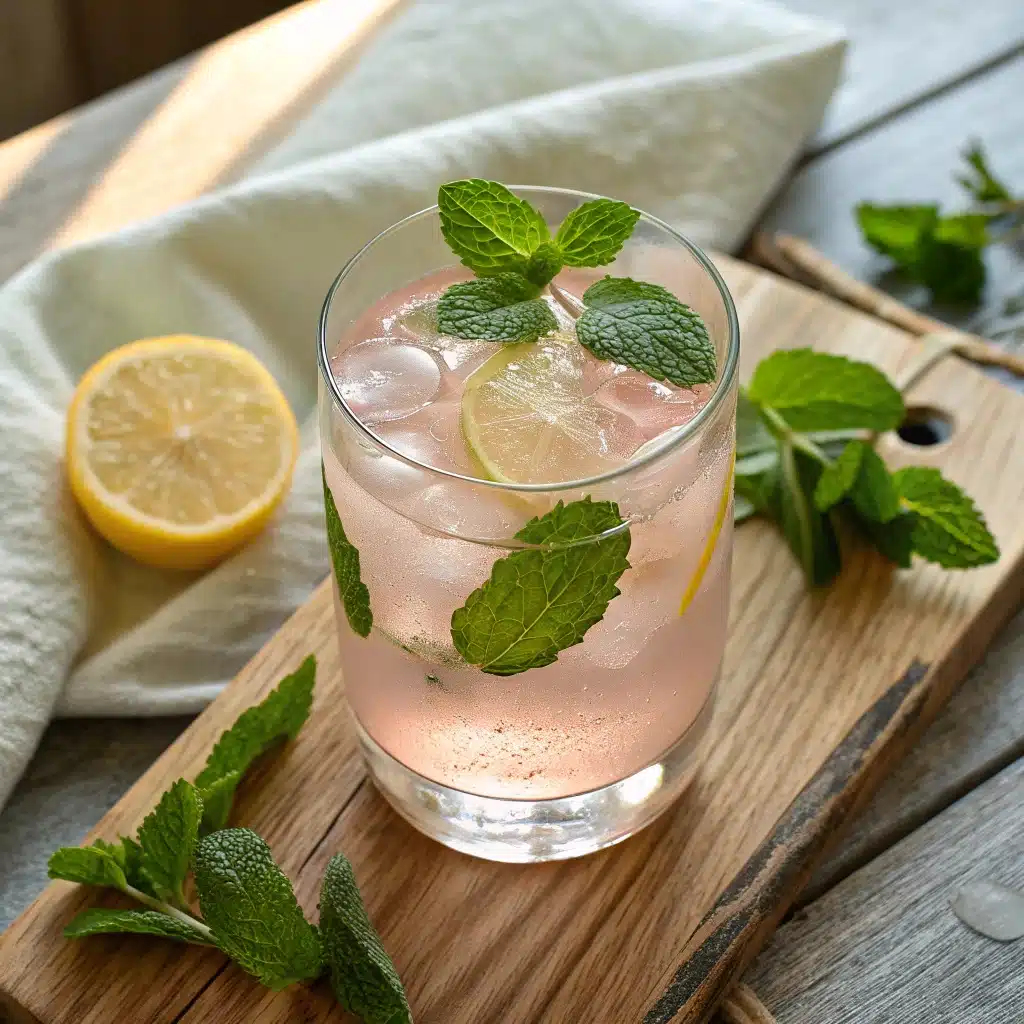
Japanese Pink Salt Recipe
Ingredients
Equipment
Method
- Boil the water.
- Bring 2 cups of filtered water to a gentle boil.
- Let it cool slightly.
- Remove from heat and let the water rest for 1 minute to avoid damaging delicate minerals.
- Stir in Japanese pink salt.
- Gently stir in 1 teaspoon of Japanese pink salt until it fully dissolves—this step is where the magic happens, so take your time to get it right.
- Add lemon juice and honey.
- Mix in the freshly squeezed lemon juice and raw honey (if using) until well combined.
- Serve warm or cold.
- Pour into a glass. Serve warm or over ice depending on your preference.
- Garnish and enjoy.
- Add a lemon slice as a garnish—it’s more than decoration; it brings a pop of brightness and a burst of citrus in every sip.
Notes
- Use fine Japanese pink salt, not coarse or Himalayan salt, for best texture and flavor.
- Raw honey adds a hint of natural sweetness and energy but is entirely optional.
- Store extra portions in a sealed glass container in the fridge for up to 24 hours.
- Try variations with mint, ginger, or chia seeds for added benefits.
- Adjust salt quantity to your taste and hydration needs.


